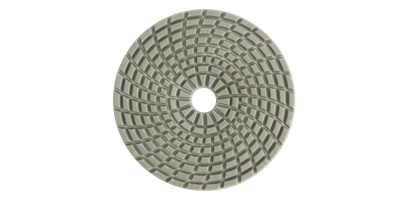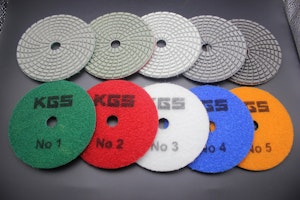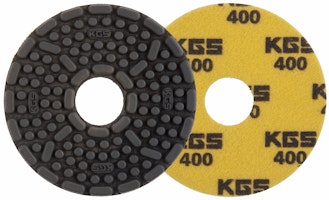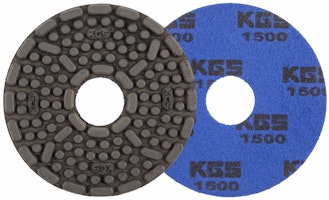Diamond Polishing Discs - wet
(See our dry polishing discs here)
Our two types of diamond wet polishing discs are a flexible pad for wet polishing all natural stones, ceramic, concrete and engineered stone.
They are long lasting and fast working.
The range we import out-perform the cheap discs available online.
Maximum speed for our 100mm wet diamond polishing pads is 8700 RPM (recommended speed 2500 - 4500RPM).
Polishing wet stops dust, and scoring from dry polishing, but slurry can sometimes be harder to clean up.
Order a back pad if you do not have one (see bottom of page).
Note - Your machine must be safe to use with water. See our polishing machines here
Tips: The final stage disc should be used with minimal water to get the best result.
It is hard to recommend a grit sequence as this will depend on individual usage and different materials.
Sometimes you may be able to skip grades on some materials, but this is generally not recommended.
Polishing results will vary according to machine and material.
Always work flat, with a little pressure. Too much pressure can shorten the disc's working life.
100mm "MM2A" discs for wet polishing concrete, marble, hard stone and ceramic:
KGS Speedline® MM-2A for efficient and fast polishing wet polishing.
Resin bond diamond polishing discs, with velcro backs.
Made by KGS with Swiss Diamond Technology.
Also ideal to polish alumina ceramic and ZTA.
Step 1 - Green, No.1 : Very coarse - Stock removal (#60 to #100 grit?)
Step 2 - Red, No.2 : Coarse - Grinding, very high efficiency l (#200 to #300 grit?)
Step 3 - White, No.3 : Medium - Smooth surface (#800 grit?)
Step 4 - Blue, No.4: Fine - Produce a clear reflective shine (#1500 grit?)
Step 5 - Orange, No.5: Very fine - Creates a good gloss (#3000 grit?)
Maximum speed - 8700RPM (recommended speed 2500 - 4500RPM)
$17 each incl GST
(or set of 5 for $72 Incl GST)


See the MM2A in action on marble below:
100mm "Pronto" for wet polishing granite and engineered stone (not concrete):
KGS Speedline® Pronto discs offer an excellent ratio of price to service life and performance.
They are perfect for wet polishing with hand held machines of different materials like granite and engineered stone.
Universal fitting with a velcro back, they offer smooth grinding yet aggressive high polishing results.
Quick stock removal.
Grits: #60, #100, #200, #400, #800, #1500 & #3000
Excellent price performance ratio.
Made by KGS with Swiss Diamond Technology
Maximum speed - 8700RPM (recommended speed 2500 - 4500RPM)
$24 each incl GST
(or set of 7 for $142 Incl GST)


Accessories:
Backing pads:
4"/100mm back pads - from $35 incl GST each
(Do not spin too fast with too much pressure - glue will overheat and velcro peel off. Not warranty)
Prices correct as of 1/9/25 but subject to change.
Silica dust - when workers cut, saw, crush, drill, grind or polish products that contain silica, particles are created, which are one-hundredth of the size of a grain of sand. These can get stuck deep in the lungs.
Ensure precautions to limit exposure to dust are in place.
See the WA government's info on silica dust here.
Please see my Contact page for Australia wide delivery information.
What is honed concrete?
Honed concrete is like exposed aggregate (where the aggregate, or rock, in the concrete are exposed, but the surface has been ground to a smoother matt finish. It is not as polished as polished concrete (see next).
After laying, the concrete needs to set for some time - a general rule is the concrete should be cured for 28 days before you start. Once set, you will need to grind of the top layer of concrete to expose the decorative stone aggregates within the mix.
Use our diamond resin polishing pads to achieve the finish the you want.
What is polished concrete?
Polished concrete is a good looking and durable finish that is obtained by polishing a concrete surface with our diamond resin polishing pads until a glossy surface is achieved.
Polished concrete is made by grinding and polishing your concrete until it reaches the desired look.
Next, a process known as hardening occurs, where the use of a hardener penetrates the concrete, creating a chemical reaction to help harden and dust proof the surface.
During concrete polishing, the surface is processed through a series of steps (in general a minimum of 6 grinding steps are completed for it to be considered polished concrete) utilising progressively finer diamond resin polishing pads.
What is "Grind and seal" concrete?
This is where the concrete substrate is ground back (usually to #200 – #400 grit) and then coated with either a polyurethane or epoxy topical coating to give the look of polished concrete without the labour intensive grinding and polishing.
Notes on polishing concrete counter tops:
Grinding and polishing results will vary according to the material, machine and operator.
Not all concrete has the strength to produce a high sheen exposed aggregate finish.
Use a tool that is rated to 2500 - 4500RPM (maximum 8700 RPM).
If dry polishing, protect yourself from silica dust with a vacuum. Remove the dust regularly, otherwise it can scratch the surface.
If wet polishing, make sure you are protected from electrocution with a RCD. The water will remove the dust, so scratching is less likely.
Which grit to use?
The lower the number, the coarser the grit, and the more material it will remove.
#60 grit is the lowest, and most aggressive pad.
The more aggressive, coarser grits work best at exposing aggregates and removing blemishes.
The higher the number, the finer the grit, and less material will be removed, and more polishing will be achieved.
#3000 grit is the lowest, and least aggressive pad that polishes the most.
The finer grits are for final polishing. Progress to higher grit levels until you achieve the desired surface sheen and smoothness.
You will need to select the grit that removes any uneven surfaces and scratches.
Double the grit size with each stage, gradually breaking down the surface irregularities until the surface is sufficiently smooth. Stop at the grit that offers the polish you want.
Trial and error with a few different pads will help you achieve the finish you need.
If you are polish only, you will get a smooth, matt surface (honed).
To get a high gloss finish, a densifier or polished concrete clear sealer from Crommelin Chemicals, Sika (both available at Bunnings for under $80 for 4 litres) or Parchem is required.
The densifier will harden the surface, increase abrasion and water resistance and reduce dusting.
The polished concrete clear sealer protects concrete surfaces from staining, dirt and water damage, and leaves a clear, wet look. It is ideal in high traffic areas, indoors and out.
See manufacturer's instructions online.
Decide on the finish you want:
Uniform Finish – The concrete is a uniform colour because there is still a thin layer of cement over the surface.
Light Polish – The thin layer of cement is removed, so a fine sand aggregate is exposed.
Ground Finish – As you polish deeper into the concrete, you begin to expose the larger aggregate (stones) that is in the concrete mix.
Clean the fully cured (minimum 10 days) concrete countertop to remove any grit that could gouge the concrete as you grind.
Patch any minor flaws or holes with a patching slurry prior to polishing. Mix up the slurry using a combination of cement, fine sand, water, and pigment.
Remove any dags or high points with one of our diamond turbo cup wheels, with water.
Start by polishing with the coarsest pad (#50 or #60 grit), depending on the desired finish.
Go over the entire surface. Use the polisher in a circular motion (in the direction that it spins) from left to right or top to bottom going halfway over the area you have already done.
Hold the polisher as flat as possible on the surface and apply even, light pressure to prevent swirl marks.
Slower speed is usually better than high speed, but you may need to experiment to see what works best with your tools/pads/job/experience.
Use hand pads of same grit to polish areas the polisher can't reach.
See our range here.
Change to a #100 grit pad and polish the entire surface again.
Repeat this process, working progressively through all the grits till the desired shine is achieved.
The level of gloss is determined by the stage at which you cease polishing in the concrete polishing process.
Full high gloss is achieved with #800, #1500 and #3000 pads.
Clean, then let the surface dry.
If applying sealer, follow the manufacturers instructions. Some sealers require the surface to be polished only to #800 grit so that it can bond to the surface, so don't over polish.
Disclaimer: the information on this website is provided in good faith and believed to be reliable and accurate at this time. However, the information is provided on the basis that the reader will be solely responsible for assessing the information and its veracity and usefulness. UDT shall in no way be liable, in negligence or howsoever, for any loss sustained or incurred by anyone relying on the information, even if such information is or turns out to be wrong, incomplete, out-of-date or misleading.
EHWA Weha
Address:
Unit 9, 84 Barberry Way
Bibra Lake WA 6163
Christmas 2025 Closure:
Close: Fri 19/12/25 at 3.30pm
Open: Tues 6/1/26 at 8.00am
Jan 2026 trading hours:
Tues, Wed & Thurs only, 8.00am to 4.00pm.
Normal trading after 3/2/26.
(ie Tues to Fri, 8.00am to 4.00pm)
